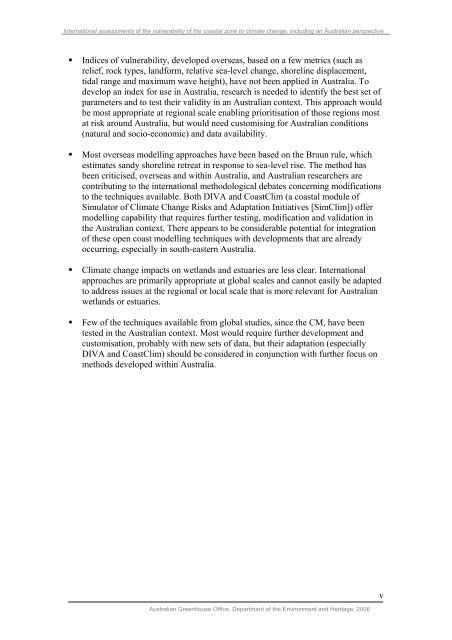International assessments of the vulnerability.pdf - Climate ...
International assessments of the vulnerability.pdf - Climate ...
International assessments of the vulnerability.pdf - Climate ...
Create successful ePaper yourself
Turn your PDF publications into a flip-book with our unique Google optimized e-Paper software.
<strong>International</strong> <strong>assessments</strong> <strong>of</strong> <strong>the</strong> <strong>vulnerability</strong> <strong>of</strong> <strong>the</strong> coastal zone to climate change, including an Australian perspective<br />
• Indices <strong>of</strong> <strong>vulnerability</strong>, developed overseas, based on a few metrics (such as<br />
relief, rock types, landform, relative sea-level change, shoreline displacement,<br />
tidal range and maximum wave height), have not been applied in Australia. To<br />
develop an index for use in Australia, research is needed to identify <strong>the</strong> best set <strong>of</strong><br />
parameters and to test <strong>the</strong>ir validity in an Australian context. This approach would<br />
be most appropriate at regional scale enabling prioritisation <strong>of</strong> those regions most<br />
at risk around Australia, but would need customising for Australian conditions<br />
(natural and socio-economic) and data availability.<br />
• Most overseas modelling approaches have been based on <strong>the</strong> Bruun rule, which<br />
estimates sandy shoreline retreat in response to sea-level rise. The method has<br />
been criticised, overseas and within Australia, and Australian researchers are<br />
contributing to <strong>the</strong> international methodological debates concerning modifications<br />
to <strong>the</strong> techniques available. Both DIVA and CoastClim (a coastal module <strong>of</strong><br />
Simulator <strong>of</strong> <strong>Climate</strong> Change Risks and Adaptation Initiatives [SimClim]) <strong>of</strong>fer<br />
modelling capability that requires fur<strong>the</strong>r testing, modification and validation in<br />
<strong>the</strong> Australian context. There appears to be considerable potential for integration<br />
<strong>of</strong> <strong>the</strong>se open coast modelling techniques with developments that are already<br />
occurring, especially in south-eastern Australia.<br />
• <strong>Climate</strong> change impacts on wetlands and estuaries are less clear. <strong>International</strong><br />
approaches are primarily appropriate at global scales and cannot easily be adapted<br />
to address issues at <strong>the</strong> regional or local scale that is more relevant for Australian<br />
wetlands or estuaries.<br />
• Few <strong>of</strong> <strong>the</strong> techniques available from global studies, since <strong>the</strong> CM, have been<br />
tested in <strong>the</strong> Australian context. Most would require fur<strong>the</strong>r development and<br />
customisation, probably with new sets <strong>of</strong> data, but <strong>the</strong>ir adaptation (especially<br />
DIVA and CoastClim) should be considered in conjunction with fur<strong>the</strong>r focus on<br />
methods developed within Australia.<br />
Australian Greenhouse Office, Department <strong>of</strong> <strong>the</strong> Environment and Heritage, 2006<br />
v

















